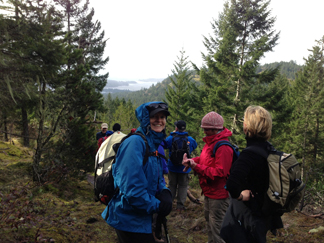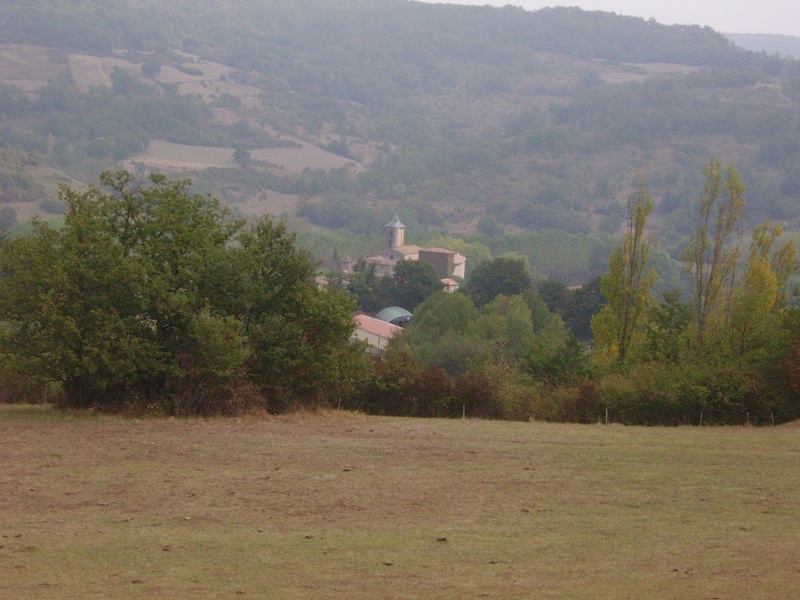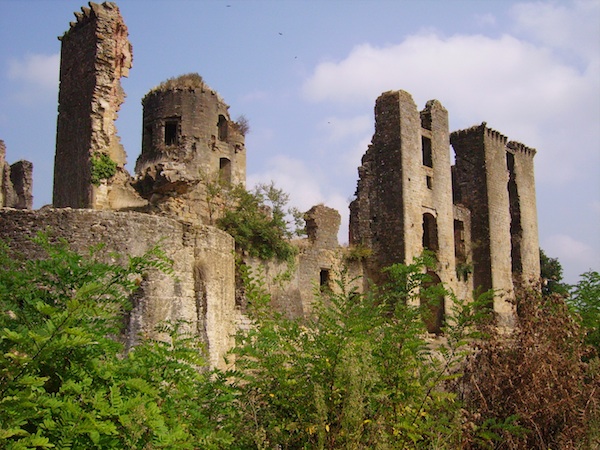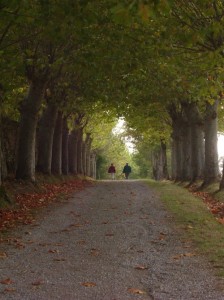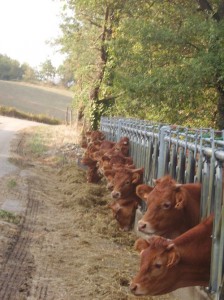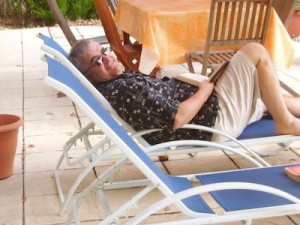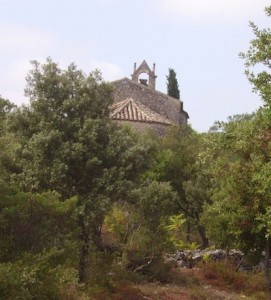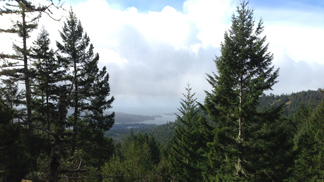
And last week, I hauled Gaston on a 15.5-kilometre circuit of four picturesque villages and settlements around where we’re staying.
The hiking guide I picked up at the tourist office in Mirepoix is without question the worst I have ever encountered. And we made route finding on this day even more challenging by going in the direction opposite from how the route was described. We did this because, after 40 minutes wandering through our 17-house village, looking for trailmarkers and way finders, that was the only trail route out of the village we could find.
We made it to Camon—yet another of France’s prettiest villages (yawn?), and covered in rose bushes abloom—where we had lunch outside the former abbey and next to the graveyard. And the route from Camon to Lagarde was straightforward once I insisted to Gaston that the rails-to-trail route we were supposed to take didn’t follow the river Hers, but crossed it on that many-arched stone bridge.
But getting out of the Lagarde was a trial.
First because Gaston had an attack of the crabbies as soon as we ducked back out through the chained chateau gates. Okay, it was hot. The cool weather had passed, and a misty morning had given away to the full blaze of the Mediterranean sun. And the trail out of Lagarde in the direction of home was, as mentioned, not clear. The only blazes we could find there for the Grand Route 7, which would lead us to Mirepoix, 8 km away.
But when you’re at the halfway point in a loop, options are limited. Retrace every footstep you’ve taken; forge ahead in the spirit of adventure (at that moment at an ebb); or brave the narrow, shoulderless road that twists along the valley bottoms and the trucks and cars traveling at 90 kph along it.
“Which would you prefer, Gaston?”
“I just don’t want a 4-km detour that we have to retrace because we’ve gone the wrong way.”
“I don’t want that either. You hated the rail-trail: do you really want to go back that way. It’ll be even hotter now.”
“I don’t want to go that way.”
“Then there’s the road or forward. Which would you prefer?”
”They’re equally long. Which do you want to do?”
”What I want isn’t the issue. I’m in better shape than you. We have to get you home.”
“I’ll go whatever way you want, but I’m not going on a wild goose chase. If you want to go forward, we’ll go forward. Is that what you want to do?”
Response not uttered.
“Do you want to take the trail?”
“Let’s see if this person can help us find the route.”
Fortunately midi was well past, and people were out and about. Un gentilhomme was passing by. I asked him for directions.
We were way off.
“Vous voulez l’autre chateau, pas celui-ci,” he said. “Il y a un autre a l’autre cote du grand chemin. Vous le verriez du village.” And he gave us step-by-step directions on how to get through Lagarde and to the grand chemin to the other chateau (Sibra)—most details of which I forgot by the time I turned to Scott and started to translate. However, I had enough—or would have if the trial signage in Lagarde made any sense. So, about 1 km from our encounter with le gentilhomme, j’ai demande encore des directionsof two ladies sitting beside the boules pitch. That got us to the next route direction-change,
where another madame taking her garden waste to the dechets bin directed us around one more corner, and then all of a sudden the directions given by le gentilhomme, les deux dame au boulodrome, and la jardinière made sense.
The route from Sibra (with a minor detour around the estate’s entire curtain wall—pregnant silence from Gaston…) to Belloc was the nicest part of the route. Well, except for the last kilometer above Belloc, a road through the middle of in intensive cattle-farm operation. But the ladies there mooed us along.
We both appreciated long hot soaks that evening.
Now, in case you were thinking Gaston is having a really unpleasant time on his vacation:
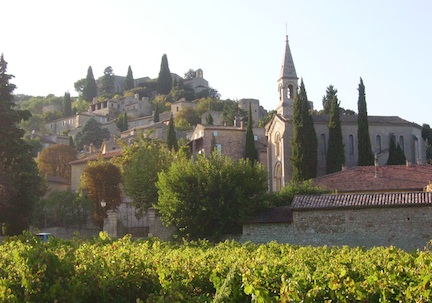 We’ve found the prettiest village in France. Officially, it’s only one of the prettiest this year and only for the past six years.
We’ve found the prettiest village in France. Officially, it’s only one of the prettiest this year and only for the past six years.
At the top of the hill is a real medieval chateau in which lives a real (presumably French, as they don’t like to sell significant symbols of their patrimony) family. I don’t know if they are of the same line of seigneurs de la Roque-sur-Cèze as the one who lived there in the 12th century, and set off to rescue the princess of Verfeuille (another picturesque walled town, about 15 minutes away driving) when he heard she was abducted.
He was successful, by the way, but on the return to the-Rock-on-the-Cèze-River (and why he was bringing her there, when he should have been bringing her home to the bosom of her loving family is a question only modern cynics would ask), she fainted at the chapel of Saint Sauveur. He awoke her with a kiss (the panacea for all damsels in distress at the time…. Or maybe it was the “kiss” that was the problem) and asked her to marry him. I’m sure that made her feel much better.
Because of this legend, the chapel has a reputation of bringing happy-ever-after to all lovers. The chapel hill is also where the monument to lost and deported victims of WWII stands, so some of the ecclesiastic ruins display graffiti from those who fought in the war.
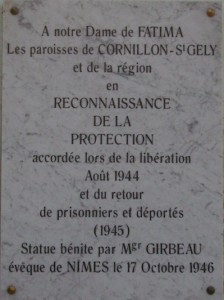 Hope and grief, on one hilltop.
Hope and grief, on one hilltop.
La Roque-sur-Cèze is one river valley and one hill away from the chapel. Judging from the names on the post boxes, the former-seigneur’s village owns its recent renaissance to an infestation of Brits. Brits with loads of moulah. Even the streets are cobbled. Ce n’est pas typique.
For instance, in another picturesque bastide (medieval walled fortress town) on a hilltop across the Cèze valley in the other direction (west) from St-Gély, Cornillon has asphalted over the cobblestones of its twisty, windy, narrow streets. I can only presume this is why the last time it was officially named “one of the prettiest villages in France” was in 2006.
It’s so darn picturesque here. Medieval buildings, “perched” villages, cafes with awnings and abrupt waiters perfunctorily serving you café ou vin (but who also remember exactly what you ordered the first time in when you wander in again two days later), and field upon field of vines.

